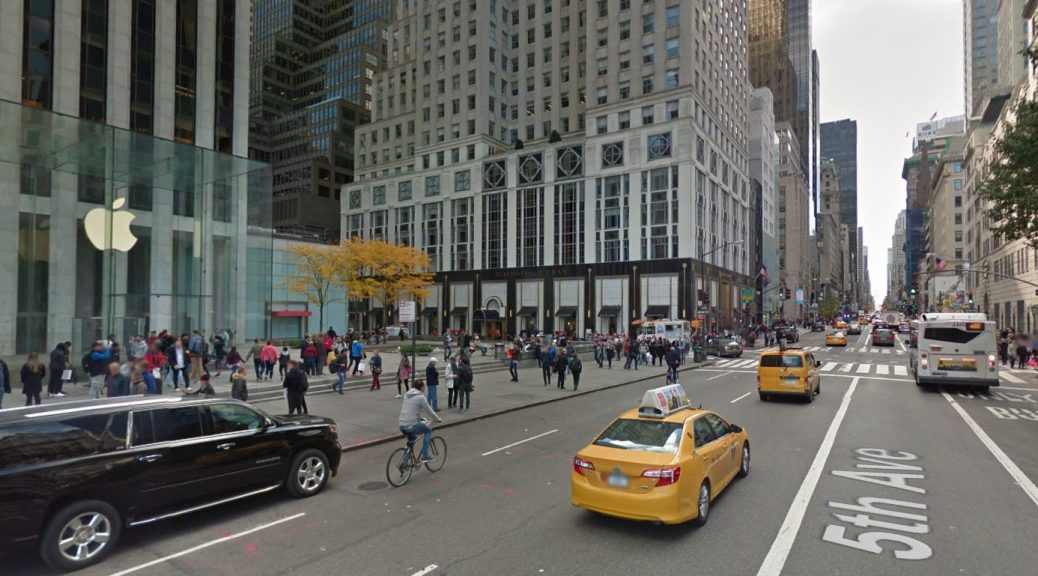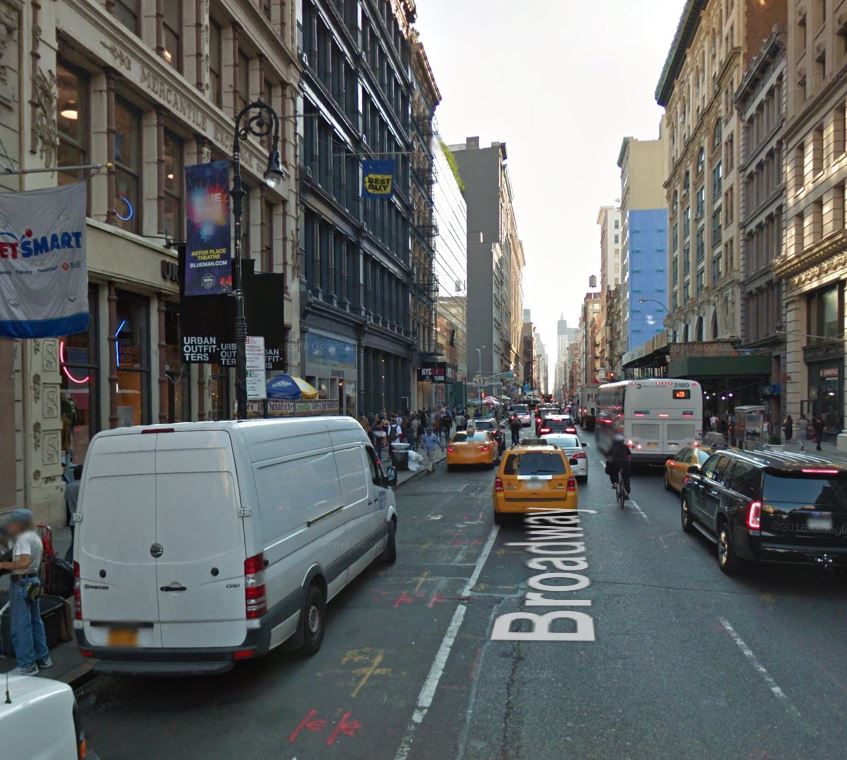
What’s a Market to Do? Looking at Fifth Avenue
Last week, Kelsey’s mom was in town. Although anyone who lives in New York knows what an out-of-town visitor means, Patty has spent time here before, so there was less mad dashing from one tourist site to another than usual. We managed to skip the Empire State Building, Grand Central and, but for going to see Kinky Boots, Times Square entirely. I managed to go above 14th Street only once. Success!
We did, however, spend some time on Lower Broadway, which is becoming ever more like its uptown counterpart. On the one block between Bleeker and Houston, there are a PetSmart, a Best Buy, an Urban Outfitters, a Journeys, a Chipotle, a Crate and Barrel, a Swatch, a Chase Bank, and an Adidas. A bit of context: the block is, according to Google Maps, 446 feet. There are some local shops, too, but the streetscape is overwhelmed by the signage of shops you can find in any suburban strip mall in the country:

As most people know, I have a strong preference for letting the market do it’s thing. As long as different businesses are playing by the same rules and are held to high standards of ethical production and employee treatment, I do think that business should go to folks achieving a balance of cost and value that their customers desire. In many places, this balance does allow many small and local businesses to continue to exist – while they might not provide the cheapest goods, people are willing to pay more for the additional value created in a community by a locally owned business.
The problems begin when businesses are not playing by the same rules. There’s an entire organization, for instance, whose mission is to track and calculate the money given away to Wal-Mart. They calculate that the company has received “more than $1.2 billion in tax breaks, free land, infrastructure assistance, low-cost financing and outright grants from state and local governments.” The policy thinking behind this is simple – and simply wrong. Local politicians think that Wal-Mart will pay taxes, employ folks, and allow their constituents to buy cheaper goods. These benefits, however, are purchased in the short term by local business owners, and in the longer term by the entire community. As money that would have been paid to local business owners is instead sent back to Arkansas, there is a huge net out-migration of capital. The money that would have been spent by local businesses in the local economy practically evaporates.
What’s happening in many parts of Manhattan, however, is a different beast. Its also one not explicitly supported by policy, which means that it’s tougher to solve. It’s most clearly demonstrated uptown, where Patty and I walked before seeing the show (Trump Tower is, by all accounts, the hippest new tourist attraction around). As Bloomberg reported in October, rents on Fifth Avenue from 49th to 60th Streets now average $3,213 per square foot. Per square foot. These are the most expensive rents in the world, and you have to sell a lot of merchandise to eke out a profit up here. Or. Or, if you’re a national retailer, the calculus is a little bit different for you. This part of the city has been synonymous with wealth and success for well over a hundred years. The Astors, the Carnegies, the Vanderbilts had mansions on Fifth and Park Avenues. These days, and for the past few decades, a retail store capable of maintaining a store front on Fifth Avenue has decidedly “made it.” What, after all, is Saks without Fifth Avenue? Because companies are so intent on having a Fifth Avenue location, they are often perfectly willing to lose money at these locations. There is some business justification for this: the perception of being that kind of store can often increase demand and allow businesses to charge higher prices. This thinking, however, leads to a market in which all participants have to be willing to accept a loss.
What this means for local businesses, however, is disastrous. A local butcher can’t decide that he’ll lose money on his shop – he can’t subsidize his storefront with sales from Wisconsin or an online arm of his business. Local businesses are entirely locked out of this market precisely because the demand for space has been bid up to artificially high levels. When big players aren’t particularly price sensitive and allow their costs to rise above their revenues all others must bow out.
A new chapter in this story is now taking shape, particularly in the most in-demand areas. As retailers have been buffeted by Amazon and other online companies, they have started to determine that the value created from being in areas such as Fifth Avenue no longer outweighs the increasing deterioration of revenue. In fact, just this week, Ralph Lauren announced that they’ll be closing their location at the corner of 55th and 5th later this month. While it’s possible that increased competition in the retail sector will impose some discipline on the market, it is unlikely that large retailers will become unwilling to accept any losses for prime locations. More worrying, perhaps, is the fact that landlords are not yet responding to declining willingness of retailers to pay astronomical rents. As retailers such as Ralph Lauren let their leases expire, landlords have chosen to let their units go empty rather than lower rents – a condition leading to a ghost town-like of empty storefronts in some of the most heavily trodden sidewalks in the country.
Taken as a unit Fifth Avenue is clearly a market aberration, if not an outright failure. A district in which firms bid up rents to such a height that they all lose money is not an inherently healthy district. At a district level, the playing field is clearly unfair: some players are able to lose money and continue to stay in business, while others are unable to do so. As long as we allow this market state to continue our cities will be doubly hit. Not only will local employers be squeezed out and unable to stay in business, the companies that do remain will be those who are sending their profits back to corporate headquarters. As this situation spreads to more and more districts in New York and other desirable cities around the country, we’ll have to sharpen our thinking and decide whether or not we think cross-subsidization of storefronts by large businesses poses enough of a threat to local businesses to warrant a policy response.
2 thoughts on “What’s a Market to Do? Looking at Fifth Avenue”
Fascinating – but you really can’t tell this whole story (or figure out a response) without looking at the other factors driving high rents in global cities. Of the macro factors, I’d highlight interest rates here and interest rates in China as the two most interesting…but I’m a China nerd with an econ degree! Other folks would tell the story differently. Regardless, for a place as “global” (i.e. of interest to global investors and relevant to industries with a TON of money) as NYC, a “local” solution has to account for these “extra” drivers.